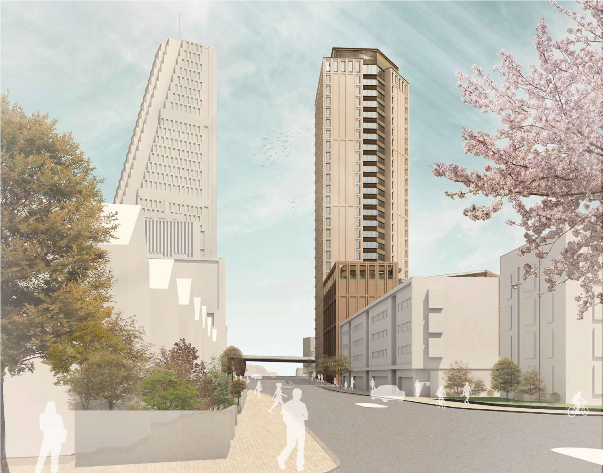Back in October 2019 our open meeting at St Helens Church hall looked at a slide image of a proposed new tower in Wood Lane, opposite the 35 storey ‘Imperial Folly’. Plans for this development have come from the Womens Pioneer Housing Association in partnership with property company HUB.
The subsequent planning applications has yet to be decided by Hammersmith & Fulham Council. Meanwhile a new residents association on the Ducane Estate has submitted an objection with 40 points ranging from the impact on local traffic, to the wind tunnel effects of very tall buildings.
It was always a concern that the decision of LBHF to grant planning approval to the Imperial tower would be followed by other proposals for very tall buildings. In this case, the planned development is for 80 flats (for existing Womens Pioneer residents) and 350 ‘co-living’ units aimed mainly at the 25-30 year old generation.

Womens Pioneer are an admirable housing association, but is this the right sort of building at the right location? And are very tall buildings, with some communal amenities inserted on several of the upper floors, a suitable form of ‘co-living’ accommodation?
The experience of Londoners stuck in in blocks of high rise flats for the last two months of lockdown has re-opened debate about the pros and cons of tall residential towers in London. This type of building is expensive to construct and maintain.
After the high rise flats built by councils in the 1960s, there were a couple of decades when few were built, following the Ronan Point collapse in 1968. The Grenfell fire has led to what the Government promises will be a major overhaul on building regulations and fire risk in residential towers.
The Collective building in Old Oak Lane is proving a successful example of co-living. But its communal areas and bar/restaurant are on the ground floor, and used by locals as well as residents. And the building is 9 storeys high rather than 39. Co-living residents are often both young and on short tenancies, and not always the first group to familiarise themselves with fire escape procedures in a single staircase tower block.
The StQW Forum has submitted a letter of objection to the application, which can be downloaded here https://stqw.org/wordpress/wp-content/uploads/StQW-representation.-final-1.pdf. Our main objection is that tall buildings are supposed to be resisted by policies in the Hammersmith & Fulham Local Plan, other than in designated regeneration areas such as White City. The Imperial tower is within the White City regeneration area but the site at 227 Wood Lane falls outside this boundary. If the Council finds a 29 storey building acceptable here, why not on e.g. the site of the Pavilion pub?
Not one of the series of tower developments granted planning consent by the Old Oak and Park Royal Development Corporation along Scrubs Lane has yet started on site. In two cases, the developer (City & Dockland) have have plans to vary and ‘optimise’ the existing planning consents by adding a further 40 housing units to each scheme. But this developer may now be having a rethink in light of the impact of Covid 19 on London’s property market.
The tall building boom in London over the last two decades may be coming to an end as patters of working, living, and commuting undergo a major transition as one aspect of a ‘new normal’..